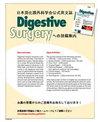引流液表皮生长因子和转化生长因子- β的高值与胰十二指肠切除术后胰瘘的发生有关
IF 1.2
3区 医学
Q3 GASTROENTEROLOGY & HEPATOLOGY
引用次数: 0
摘要
导言:术后炎症反应可能是胰十二指肠切除术后吻合口衰竭的主要决定因素。在这项初步研究中,我们研究了引流液细胞因子在预测术后胰瘘(POPF)中的潜在作用。方法:用POD1测定引流液中TGF-β、IGF-1、EGF、IL-6及血清淀粉酶、引流液中淀粉酶的变化,并与POPF的发生进行相关性分析。结果:研究人群包括66例患者。POPF和Clavien-Dindo≥3的发病率分别为12.1%和9.1%。POPF患者的POD1血清淀粉酶水平(477 vs. 54 UI/L, p < 0.001)、引流液淀粉酶(7500 vs. 127 UI/L, p < 0.001)、TGFβ (94 vs. 40 pg/g, p = 0.045)和EGF (17 vs. 13, p = 0.015)均显著升高。在IGF-1和IL-6值方面没有差异。结论:评估胰十二指肠切除术后局部炎症反应可能是一个有前途的研究领域,因为TGFβ和EGF似乎与POPF的发生有关。本文章由计算机程序翻译,如有差异,请以英文原文为准。
High Values of Drain Fluid Epidermal Growth Factor and Transforming Growth Factor-Beta Are Associated with the Development of Pancreatic Fistula after Pancreatoduodenectomy
Introduction: Postoperative inflammatory response may act as a major determinant of anastomotic failure after pancreaticoduodenectomy. In this pilot study, we investigated the potential role of drain fluid cytokines in predicting postoperative pancreatic fistula (POPF). Methods: Drain fluid TGF-β, IGF-1, EGF, and IL-6, together with serum amylase and drain fluid amylase, were measured on POD1 and correlated with the development of POPF. Results: The study population consisted of 66 patients. POPF and Clavien-Dindo ≥3 morbidity rates were 12.1% and 9.1%, respectively. Patients developing POPF presented significantly higher values of POD1 serum amylase level (477 vs. 54 UI/L, p < 0.001), drain fluid amylase (7,500 vs. 127 UI/L, p < 0.001), TGFβ (94 vs. 40 pg/g, p = 0.045), and EGF (17 vs. 13, p = 0.015). There were no differences in terms of IGF-1 and IL-6 values. Conclusion: Assessing the local inflammatory response after pancreatoduodenectomy could represent a promising field of research since both TGFβ and EGF seem to be associated with the occurrence of POPF.
求助全文
通过发布文献求助,成功后即可免费获取论文全文。
去求助
来源期刊

Digestive Surgery
医学-外科
CiteScore
4.90
自引率
3.70%
发文量
25
审稿时长
3 months
期刊介绍:
''Digestive Surgery'' presents a comprehensive overview in the field of gastrointestinal surgery. Interdisciplinary in scope, the journal keeps the specialist aware of advances in all fields that contribute to improvements in the diagnosis and treatment of gastrointestinal disease. Particular emphasis is given to articles that evaluate not only recent clinical developments, especially clinical trials and technical innovations such as new endoscopic and laparoscopic procedures, but also relevant translational research. Each contribution is carefully aligned with the need of the digestive surgeon. Thus, the journal is an important component of the continuing medical education of surgeons who want their practice to benefit from a familiarity with new knowledge in all its dimensions.
 求助内容:
求助内容: 应助结果提醒方式:
应助结果提醒方式:


